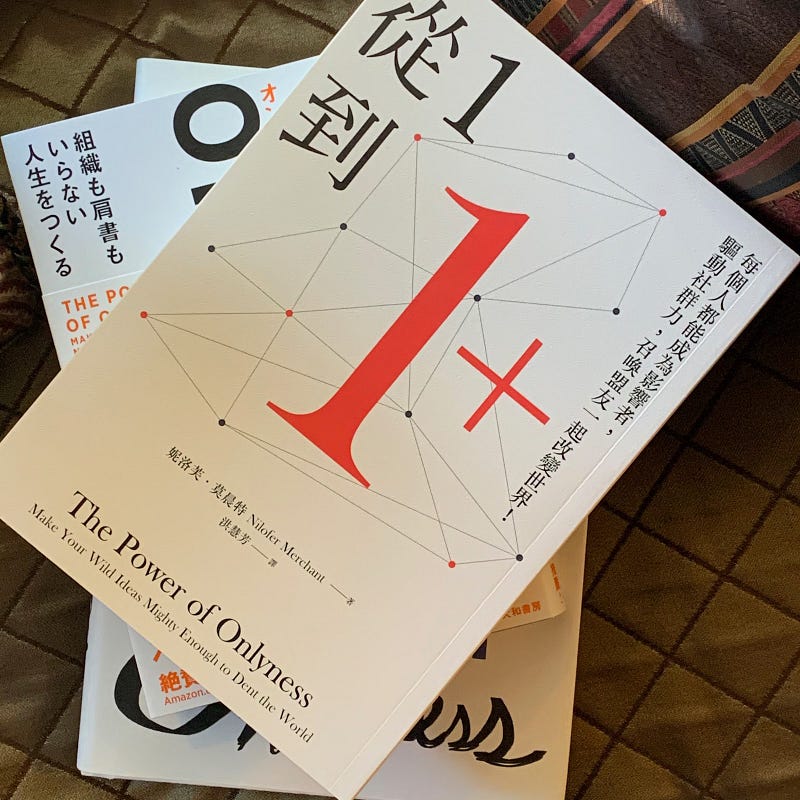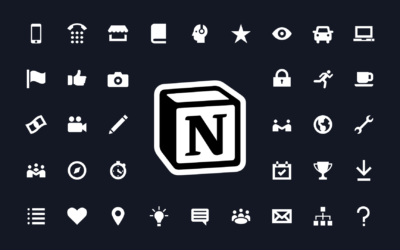During her 25 years in technology, Nilofer Merchant has personally launched more than 100 products, netting $18B in sales. She helped launch the first Internet Server at Apple, grew division performance at Autodesk by 50 percent, and created product and pricing strategies for Adobe that grew the company from $2B to $5B. She has been recognized as a top business thinker, her TED Talk ranks in the top 10% in the world, and her ideas about redesigning work … actually work.
We caught up with Nilofer to learn more about her work, what she sees as the biggest opportunities to support the rise of more women in leadership, and what inspires her when she looks to the future.
Hi Nilofer! Tell us about yourself — how did you get to where you are today?
I started my tech career as an administrative assistant. Today, I am a top ranked management and HR thinker shaping the future of work. That’s not such a path, as much as it is a wonder.
I was going to school while working because I got kicked out of my very traditional Islamic, immigrant family for wanting an education vs. getting an arranged marriage. From that early start, I went on to to run a program that no one else wanted (they thought it was a career death trap) that grew a portion of Apple’s business from a measly $2M to $180M in a really short 18 months. When Jobs returned to Apple, this program was literally the only growing, only profitable part of the business, which is pretty remarkable in its own light. It also ended up being the template for Apple’s future retail stores. And the product we were selling? The first web servers. If I look back at my career, it has always been taking on the project that everyone has failed at or thinks will fail, and finding a new way of looking at it to drive the next level of performance. My career has now spanned executive roles (VP of major Fortune 500s, etc.) as well as corporate board roles, but I’ve never forgotten my roots of knowing what it is to be ignored simply because one doesn’t have the “right” title or status in the room.
Today, I write and speak not because I aimed to do so. I just finally started saying — claiming that which “only” I saw — what I felt needed to be said. I was literally sitting at home in my pjs when I got a note asking if I’d write for Harvard Business Review. Equally, I got approached by a speakers bureau after giving a lecture at a relatively no-name institution. All of this work has been an exercise in claiming what only one can, which as I’ve already written is not a private act, but a social one. I’ve gotten to where I am today by hearing the sound of my soul, because I have people who can help me to hear it.

With over 25 years of experience in tech, you’ve launched more than 100 products and led industry-shaping initiatives at companies like Apple, Autodesk, and Adobe. What’s one of the biggest lessons you’ve learned over the course of your career?
In spite of all the advertising slogans, the world doesn’t change one person at a time. It changes because of networks of relationships that then share a common cause and vision of what’s possible.
I wish I had understood that a long time ago. Because we — and by that I mean women — get told to fix themselves as if that’s the problem. That explains all the books on grit, confidence, and such. We are told to “lean in” to get paid equally, which is ridiculous if you think about it. The author of that idea could actually fix the system (she serves on the exec team as well as the board of Facebook, after all) that keeps equal pay from happening, but instead she sells us (and earns money doing so) on suggesting we women should be doing more.
My biggest lesson is to see that none of us are somehow broken, that we need to be fixed. Instead, the systems and scaffolding that keeps us from being heard and valued need to be fixed. Every time you hear of things like imposter syndrome or being asked to speak up more (when you already are), recognize this as a way of making you do more instead of making things work. The lesson then is, instead of trying to self-help our way to progress, let’s join together to create the social structures that let us each count.
In your book, “The Power of Onlyness,” you talk about the incredible opportunities technology and the internet have created for ideas to spread and scale through networks instead of hierarchies. Can you describe the idea of “onlyness” for those who may not be familiar? What is a key change individuals in leadership should make to support more inclusion and equity in the workplace, particularly around creativity, innovation and lifting up ideas from underrepresented groups?
Ah, Onlyness. Even if you’ve never heard the word, you know what it is. How each of us, simply by standing in a spot in the world only one stands in, has a perspective or knowledge or ideas for what is possible. It is the source of ideas.
Some people want to confuse or conflate it with branding-type stuff, which is weird because branding already has a word. I do understand the socialized instinct; it suggests that the way you add value is by standing out from the crowd. But see above; despite all the advertising stuff, the world doesn’t change one person at a time, it changes by our connection. Onlyness is not saying “you’re special,” it is saying that EACH of us, simply by being ourselves, has a capacity to add value. Instead of standing out, onlyness is how we figure out who we stand with and that by the power of this connection, we can then affect change.
I coined the word to point to a shift in value-creation. For the longest time, the way to create value was organization-centric. Whether it was agriculture making money off of slave labor, or a Ford Motor-type company dividing up big tasks into subtasks, value creation was tied to how the different “parts” did their part of one big thing. Today, we can see that connected individuals gathered together are the ones adding value. We see it in the way Twitter is made up from all of us adding our bit. The value creation part is done by the sum of us, not it.
This shift — from doing a part of the whole, to how we can each add our wholeness — it’s a tectonic shift.
While some people see onlyness as a path to diversity, it is not asking us to add some “diversity” to an existing thing, like adding frosting to a cake. Onlyness acknowledges the capacity — for innovation, change-making, creativity — already exists. It’s everywhere, and prevalent. And so the question, or onus perhaps, is what is it you’re doing to tap it.
I spent 7 years studying how to use networks to make change and then, step by step, deconstructed what was needed. Organizations have had nearly 50 years of data to say diversity is material and yet relatively little has changed. Maybe we should stop asking for some frosting and make a new cake recipe — or just a new recipe. We don’t have to necessarily make a cake, we can make as many desserts as we can each imagine.
One of your key workplace hacks has been to make your meetings walking meetings. In addition to the health benefits, what are some of the creative and business benefits to taking meetings this way?
Yes, I got a chance in 2013 to do a main stage TED talk (not a TedX) on the topic of walking meetings. Bono actually followed me on stage and being in the green room with him was its own story for another time. But, when I got asked to give this talk, I actually laughed and nearly passed when I got that request. Because, it’s not a new idea (I have actual new big ideas from my vocational work on how power powers ideas). But, I had gone on several walking meetings with people on the core TED team, and they had all changed their habits, so they found themselves listening better, more present to problem solving, and healthier to boot. And so they encouraged me to help make the cultural shift to kill the meeting rooms and get outside. Today, the idea has been quoted in nearly every major media outlet around the world (399,999,900 million times according to the latest Google search results) and has shifted culture. You know the phrase, how you do one thing is how you do everything? This is what this talk is. How if enough people adopt a new practice, we enable a larger change. That’s kind of my life’s calling, if I think about it. I walk the talk, so to speak, and ask others to join me in making a shift in how we work.
What do you see as some of the biggest opportunities to support the rise of more women in leadership right now?
I just finished something like 12 months of research on women and power. And I entitled the related essay, why we still don’t have what we’re looking for. I beg you to read it in full. But, the title says it all. I am doing a riff on U2’s song, Why I Still Haven’t Found What I’m Looking For. And I’m shifting it to “we” because that’s the key. We do not understand power as women.
Having studied 150+ years of women’s leadership, I would bottom line it as this:
If you seek power from those who have it, you end up being a pawn in an existing system. By seeking a white man’s gaze, you adopt his premise. But if you seek progress, you end up finding those with whom you share purpose, and then make the power necessary to effect real change.
What does that look like in real life?
A really good friend of mine, a true change-maker and someone I’ve admired long before I met, recently joined a group of friends in a project. The three women she joined are lovely people…exceptional as brand-builders, good at saying the pithy thing and getting quoted. Good at building events, even that include a wide variety of women. But, I had noticed how they never pay those women. So they create conferences that have all the optics of “empowerment,” but no actual power-making. I asked my friend, what are her friends advancing? From my angle, it seemed like it was… themselves. They spoke of change, yes, but for their own higher pecking order. My friend who joined them? She has actually built programs and created metrics that have effected change in the system. When I asked her why she was joining their project, she answered it was because they had asked her. She felt lonely, you see, and she thought that being with them would ease that pain.
But, I worry for her. And for all of us who make this similar decision. Loneliness can be about getting emotional support. It can also be about missing meaning. But, I’ve long wondered if those two aren’t one and the same. Loneliness is not just a function of being or not being with someone else, but a lack of shared meaning. After all, if you don’t know what you stand for, you can never actually understand who your people are and to whom you belong. So, even if you’re in the room, you’re not seen as you are.
This is the work. Until one understands what it is that “only” you have to offer, you can’t find your purpose. Without your purpose to guide you, you can’t find your people. And until you find your people, you will never have the power of agency. You will, instead, hang out with those who are carving out their own pecking order and then your “value” comes not from that intrinsic sense of what matters to you, but from someone else being less than you. It’s a hollow way of being, this pecking order of power.
But, there is another way. A way of gathering around purpose to build what comes next: Onlyness. How networks of people can do what once only large organizations could, because they know who they are.
At Noun Project, we believe visual language has the power to shape, reinforce and change perceptions. What are your thoughts on the importance of visual representation to help change the status quo and champion more women in leadership across industries?

This book jacket communicates so much about the idea of “onlyness.” Each of us matters, yes – so, the 1. And also how we’re always a part of something. It’s never about just one voice, or one person being special but about how we join together to make something happen.
The 1 is not apart from the +. They are a part of a larger visual story. American culture often reinforces the idea you’re on your own, and if you don’t succeed, you just haven’t tried enough. But that’s not how life actually works. We need more visual language to communicate how linked we actually are.
When you look to the future, what inspires you and what initiatives are you currently most excited about?
Lately I’ve been writing an advice column about the future.
We all want to show up to work, fully alive — and then sh*t happens. Excited by a creative project, yet stuck in anxiety. Confused by having an idea stolen and the boss saying it’s just business-as-usual. Wondering what to do if you’re offered a big job (& big money) even though it means working with people who don’t get you.
Hence, this initiative. Real-life dilemmas and us craning over the wreckage to spot how we might avoid the same. Spotting that the question being asked is not the question that needs to be asked. Seeing all the ways we’re socialized to believe that there is only so much power, or capacity or whatever to go around. Learning new ways of working. From scarcity to abundance. From competing to collaboration. From I to ours.
Better is possible. Not just making work-life suck less. No — we want to do work that matters more. Yet we don’t know how. At least, not consistently. Not sufficiently. Not clearly. But with @work, we map this terrain, this new progress of being at work. I’m excited by everyone joining and the conversations being had.
What advice would you give to women currently navigating the path to leadership in the workplace, their communities and beyond?
Here’s the thing — we’ve never in the history of work or political life seen a world where women lead. It’s never happened before. Even today, with white men representing 31% of the population, they hold 80% of *all* elected seats in the US. Similarly in business, similarly in other leadership roles. Women might be “firsts” and “onlys” but, by definition, this means cannot be their fullest expression of themselves.
So none of us know what a world of women leading would look like, because it’s never existed before. Sometimes we talk about it as the opposite of male, but this does it a disservice, don’t you think? Just as I am not something or someone as compared to you, leadership that has feminist qualities is not the opposite of male leadership. It is going to be something of itself.
What will that be? I don’t know. Neither do you. Because it doesn’t exist, as of yet.
Which is why I don’t claim to have answers (as if there was such a thing), but instead seek to find those people with whom I can keep learning. By forming better questions and making sense of what could be. Again, not the sense. But, a sense. So that you and I can see things anew, maybe try new ways of relating to work, and to put x into practice. (If that’s your groove, do join in the @work community; you’d be so welcome to become part of a community putting into practice Onlyness.)
Which is my way of saying find a community where you can navigate the path. Choose carefully so you aren’t in places trying to make you do more or to fix you; choose places that enable you to practice and build agency, so your full throated voice can be heard and in such a way that you find yourself saying “Honk” and you hear back a “Honk Honk.” So that you will find yourself being called into your place in the world.
For more from Nilofer, join the @work community at atwork.substack.com. You can also visit Nilofer’s website, follow her on Twitter, and read her latest book, The Power of Onlyness.
This interview is part of our Empowered Women series in partnership with FREE THE WORK, The 3% Movement, The Female Quotient, and TIME’S UP Foundation — a coalition effort to champion more equal and accurate representation of women leading at work, at home, in their communities and beyond. Read more about this initiative here and download images from the Empowered Women collection here.
About The 3% Movement
Started to spotlight a huge business opportunity in advertising — the lack of female creative leadership and its impact on connecting with an overwhelmingly female marketplace — The 3% Movement has grown exponentially since its 2012 launch. Hosting events in 27 cities globally and offering consulting and certification programs that amplify creative cultures, 3% has helped drive the number of female creative directors in the U.S. from 3% to 29%.





